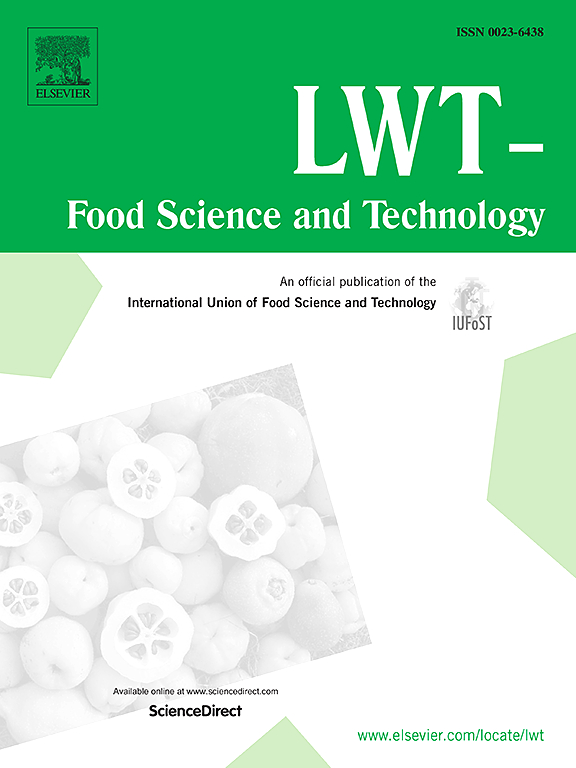Removal of cadmium, lead, and chromium by Lactobacillus helveticus KD-3: Influential factors, adsorption mechanism, and application in goat milk powder
IF 6
1区 农林科学
Q1 FOOD SCIENCE & TECHNOLOGY
引用次数: 0
Abstract
The Lactobacillus helveticus KD-3 strain that could remove cadmium (Cd), lead (Pb), and chromium (Cr) was selected to explore the effect of temperature (4–40 °C), bacterial concentration (2.0–10.0 g/L), adsorption time (0.1–6.0 h), and pH (2.0–8.0) on the removal rates of these heavy metals. The adsorption mechanism of single and mixed heavy metals was revealed through SEM-EDS, FTIR, and XPS. When the adsorption temperature was 40 °C, the maximum removal rate of Cd was 29.08 %. At pH 6.0 and 4.0, the maximum removal rates of Pb and Cr were 83.37 % and 49.16 %, respectively. The cell surface showed obvious wrinkles after absorption, suggesting that Cd, Pb, and Cr were toxic to KD-3. The main biosorption mechanism was the binding of heavy metals to functional groups (N–H, O–H, C–H, COO−, and C–O–C). XPS analysis confirmed the reduction of Cr(Ⅵ) to Cr(Ⅲ) after adsorption. In addition, goat milk powder containing 4.3 × 108 CFU/g of KD-3 was prepared and demonstrated the ability to remove coexisting Cd and Pb in vitro effectively. This study emphasizes the significance of adsorption conditions, provides insights into the adsorption mechanism, and further exhibits the potential for L. helveticus KD-3 to adsorb mixed heavy metals in the food industry.
helveticus乳杆菌KD-3对镉、铅、铬的去除:影响因素、吸附机理及其在羊奶粉中的应用
选取能去除镉、铅、铬的helveticus乳杆菌KD-3菌株,考察温度(4 ~ 40℃)、菌体浓度(2.0 ~ 10.0 g/L)、吸附时间(0.1 ~ 6.0 h)和pH(2.0 ~ 8.0)对镉、铅、铬去除率的影响。通过SEM-EDS、FTIR、XPS等分析了其对单一和混合重金属的吸附机理。当吸附温度为40℃时,Cd的最大去除率为29.08%。pH为6.0和4.0时,对Pb和Cr的最大去除率分别为83.37%和49.16%。吸收后细胞表面出现明显皱纹,提示Cd、Pb、Cr对KD-3具有毒性。主要的生物吸附机制是重金属与官能团(N-H、O-H、C-H、COO−和C-O-C)的结合。XPS分析证实吸附后Cr(Ⅵ)还原为Cr(Ⅲ)。此外,制备了含有4.3 × 108 CFU/g KD-3的山羊奶粉,并显示出体外有效去除共存Cd和Pb的能力。本研究强调了吸附条件的重要性,揭示了L. helveticus KD-3的吸附机理,进一步展示了L. helveticus KD-3在食品工业中对混合重金属的吸附潜力。
本文章由计算机程序翻译,如有差异,请以英文原文为准。
求助全文
约1分钟内获得全文
求助全文
来源期刊

LWT - Food Science and Technology
工程技术-食品科技
CiteScore
11.80
自引率
6.70%
发文量
1724
审稿时长
65 days
期刊介绍:
LWT - Food Science and Technology is an international journal that publishes innovative papers in the fields of food chemistry, biochemistry, microbiology, technology and nutrition. The work described should be innovative either in the approach or in the methods used. The significance of the results either for the science community or for the food industry must also be specified. Contributions written in English are welcomed in the form of review articles, short reviews, research papers, and research notes. Papers featuring animal trials and cell cultures are outside the scope of the journal and will not be considered for publication.
 求助内容:
求助内容: 应助结果提醒方式:
应助结果提醒方式:


